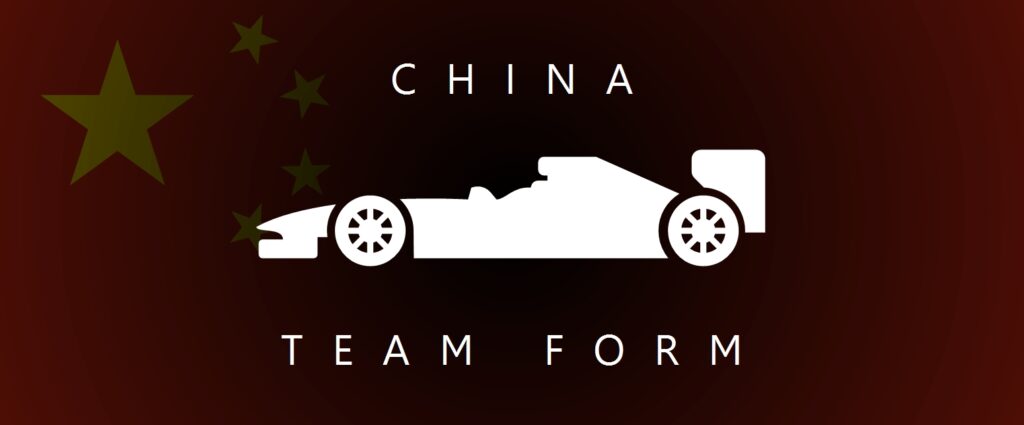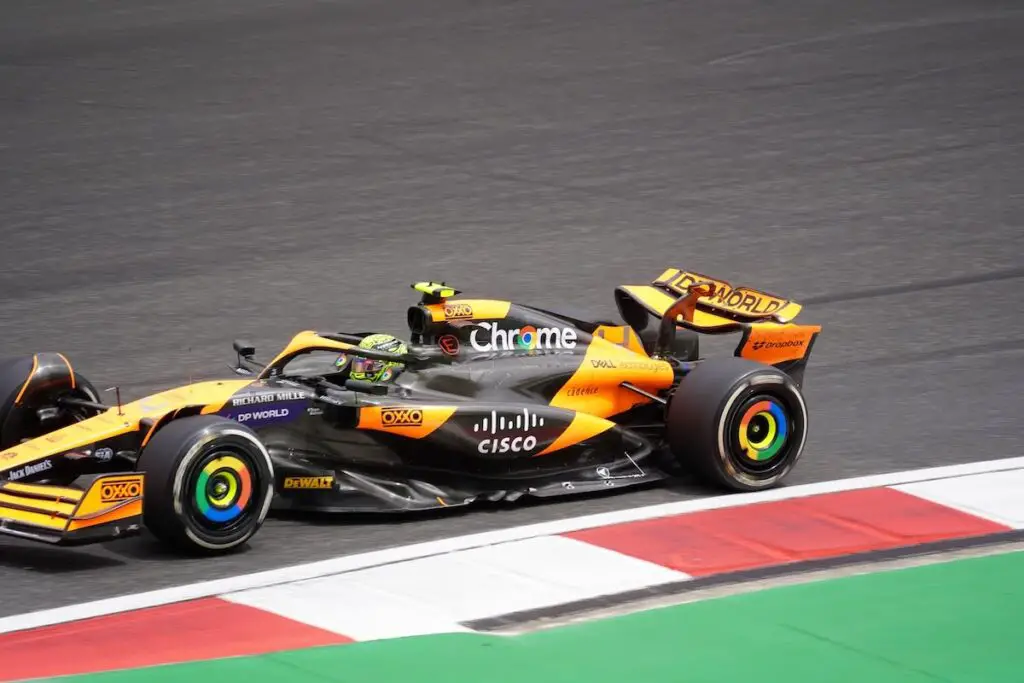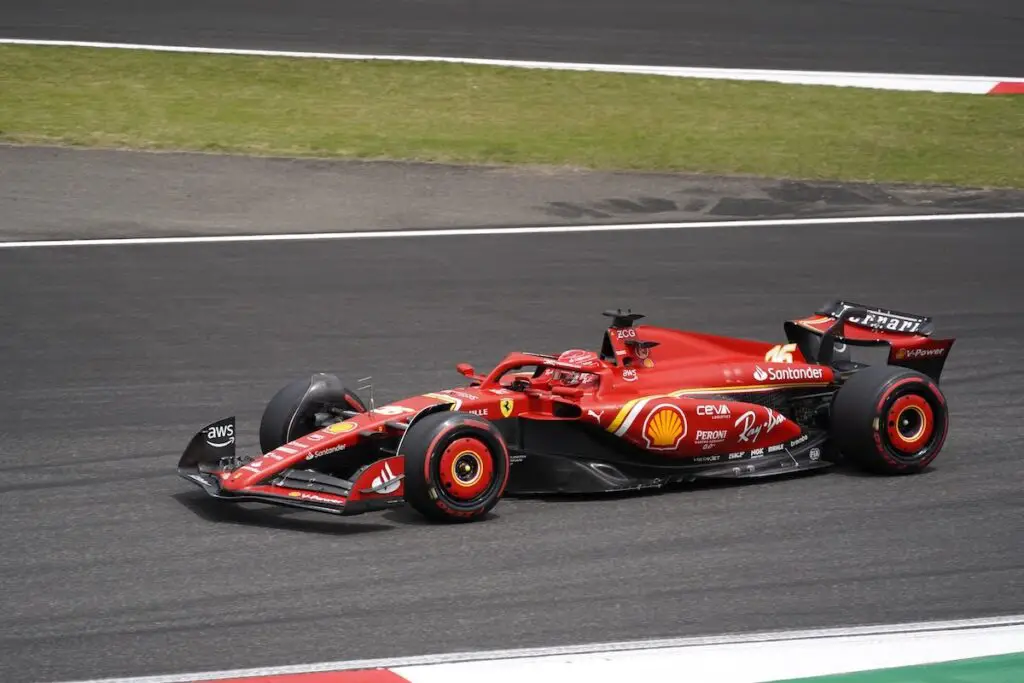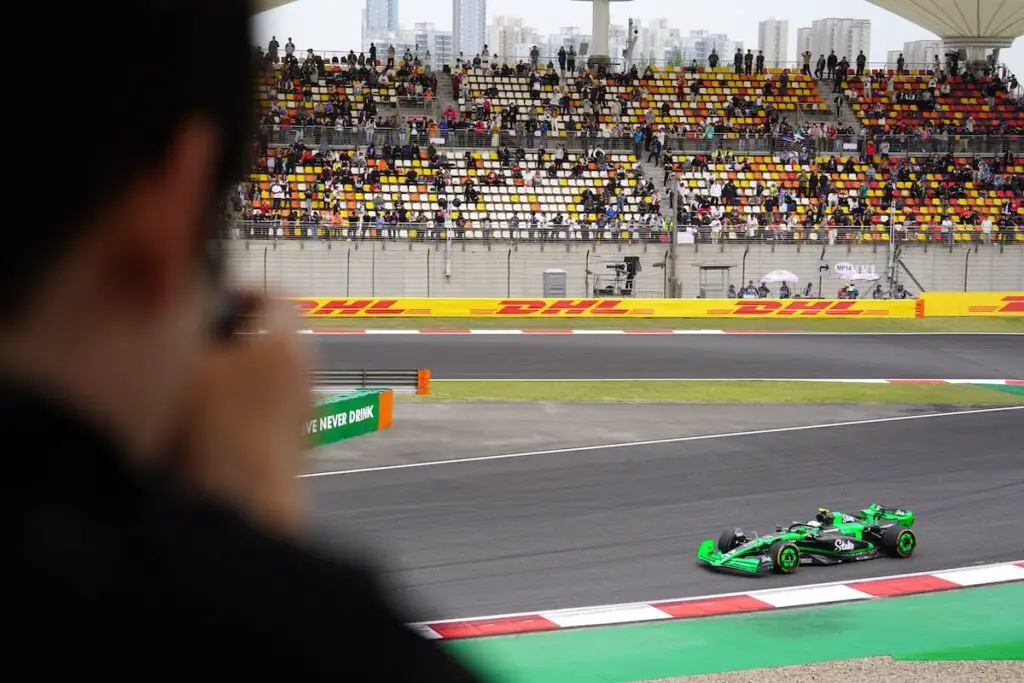
Red Bull and Mercedes have won the last seven Chinese Grands Prix, while Ferrari have the most podiums in Shanghai. Here’s everything you need to know about each team’s history at the Chinese Grand Prix!
McLAREN
WINS: 3, POLES: 2, PODIUMS: 10 | 2024 CHINESE GRAND PRIX RESULT: NORRIS 2nd, PIASTRI 8th
McLaren took their Chinese Grand Prix 1-2 result in 2010. Lewis Hamilton won the event for the team again in 2011, while both he and Jenson Button finished on the podium in the following season.
Between 2013 and 2019, there were only two occasions on which McLaren scored points at the Chinese Grand Prix: Jenson Button finished fifth in 2013, while Fernando Alonso finished seventh in 2018.
McLaren returned to the Chinese Grand Prix for the first time in 12 years in 2024, with Lando Norris finishing as runner-up. Oscar Piastri finished eighth, making it the first time both McLaren drivers finished in the points in Shanghai since 2012.
McLaren have had seven DNFs in total here, including a double DNF in 2017 and, most recently, a retirement for Norris in 2019.

McLaren have taken pole twice for the Chinese Grand Prix, both times with Lewis Hamilton at the wheel in 2007 and 2008. Lando Norris also secured pole position for the Sprint event over the 2024 Chinese Grand Prix weekend.
The team’s only other front row starts at the track came in 2004, courtesy of Kimi Raikkonen, Jenson Button in 2011 and Hamilton once again in 2012. With Norris fourth and Oscar Piastri fifth in qualifying for the 2024 Chinese Grand Prix, McLaren reached Q3 at the track for the first time since 2013.
2015 marks McLaren’s only double Q1 exit at the track, while Stoffel Vandoorne’s Q1 exit in 2017 is the only other time the team has failed to progress to the second part of qualifying.
FERRARI
WINS: 4, POLES: 2, PODIUMS: 13 | 2024 CHINESE GRAND PRIX RESULT: LECLERC 4th, SAINZ 5th
2024 was the first time since 2012 that neither Ferrari driver finished on the podium at the Chinese Grand Prix. While Fernando Alonso’s victory here in 2013 remains their latest win to date in Shanghai, since 2010, Felipe Massa’s 13th place finish in 2012 is the only occasion on which a Ferrari car has finished outside the points.
2005 and 2009 are the only times Ferrari left China having not picked up a point. They’ve only ever recorded three DNFs at the circuit – one for Michael Schumacher in 2005 and two for Felipe Massa, in 2006 and 2009.

Ferrari locked-out the front row at the Chinese Grand Prix for the first time in 2018. They had previously taken pole in 2004, and three front row qualifying results in 2007, 2008 and 2017. Sebastian Vettel and Charles Leclerc locked out the second row of the grid in the 2019 event, while 2024 was the first time since 2012 that neither of the team’s cars qualified in the top five at the track.
A Ferrari driver has never been eliminated in Q1 in China, but they have had four Q2 exits; most recently with Kimi Raikkonen in 2014. At least one Ferrari has appeared in the final part of qualifying in every season since the knockout system was introduced in 2006.
The team book-ended the grid for the inaugural race here, as Rubens Barrichello started from pole and Michael Schumacher started from the back, having failed to set a qualifying time.
RED BULL
WINS: 3, POLES: 4, PODIUMS: 9 | 2024 CHINESE GRAND PRIX RESULT: VERSTAPPEN 1st, PEREZ 3rd
Red Bull claimed their first ever F1 victory at the Shanghai International Circuit in 2009, while Daniel Ricciardo provided the team with their second Chinese Grand Prix win in 2018. The team claimed their third Shanghai victory on F1’s return to the track in 2024, with Max Verstappen securing the win.
Since 2016, the 2019 Chinese Grand Prix is the only Shanghai race in which neither Red Bull driver has finished on the podium. The team have finished on the podium with both cars here on three occasions, in 2009, 2011 and 2024. 2009 is Red Bull’s only 1-2 finish to date at the circuit.
Red Bull have failed to pick up points at the Chinese Grand Prix only twice, in 2006 and 2008, and have only recorded two DNFs – one for Mark Webber in 2013 and one for Daniil Kvyat in 2015. Those DNFs are the only occasions in the past eleven Shanghai races on which Red Bull have failed to finish with both cars in the points at the Chinese Grand Prix.

In 2024, Red Bull locked-out the front row at the Chinese Grand Prix for the first time since 2010. They’ve taken pole four times here, with Verstappen’s 2024 pole being the team’s first pole at the track since Vettel’s in 2011. Between 2011 and 2024, they recorded only two front row qualifications – both courtesy of Daniel Ricciardo, in 2014 and 2016.
The team have seen both of their cars reach the final part of qualifying on eight occasions in total, but have also suffered four Q2 exits and three Q1 knockouts. Their most recent non-Q3 appearance was in 2017.
MERCEDES
WINS: 6, POLES: 7, PODIUMS: 12 | 2024 CHINESE GRAND PRIX RESULT: RUSSELL 6th, HAMILTON 9th
Mercedes have scored more points at the Chinese Grand Prix than any other team. The team have won here six times and there has never been an occasion on which they’ve left Shanghai without points.
The team won all but one of the six races in Shanghai between 2014 and 2019. They have had six wins in total here, with Nico Rosberg’s 2012 win marking Mercedes’ first victory in the modern era of Formula 1.
With George Russell finishing sixth and Lewis Hamilton ninth, 2024 was only the second time – in addition to 2011 – that neither Mercedes driver finished on the podium at the Chinese Grand Prix since the team returned to the sport in 2010.
DNFs for Michael Schumacher in 2012 and Nico Rosberg in 2013 are the only two occasions where a Mercedes car has failed to finish within the points here.
Mercedes have claimed pole position for the Chinese Grand Prix seven times, locking out the front row twice, in 2015 and 2019. 2018 is the only time in the eight Shanghai races between 2012 and 2019 that neither Mercedes driver took pole nor qualified on the front row of the grid.
Michael Schumacher’s Q2 exit in 2011 and Lewis Hamilton’s Q1 exits in 2016 and 2024 are the only times Mercedes’ cars haven’t featured in the final part of qualifying here since 2010.
ASTON MARTIN
WINS: 0, POLES: 0, PODIUMS: 0 | 2024 CHINESE GRAND PRIX RESULT: ALONSO 7th, STROLL 15th
The Silverstone-based team do not have a high points finishing rate at the Chinese Grand Prix. If you take all of their entries under every team name dating back to 2004, the team have scored on only seven occasions. With seventh place in 2024, Fernando Alonso scored the team’s best result at the track in the last six Shanghai races.
Their best finish here came in 2014, when Nico Hulkenberg crossed the line in sixth. 2014 and 2017 are the only seasons in which both of the team’s cars have finished in the points in Shanghai. Force India recorded five DNFs at the track, but both cars have made it to the end of all of the last five Chinese Grands Prix.
2016 is the only year in which both Force Indias qualified in the top ten. In total, the team have reached the final part of qualifying eight times, with at least one of their cars progressing to the top ten shootout in four of the last five Shanghai races.
With third on the grid at the 2024 Chinese Grand Prix, Fernando Alonso recorded the Silverstone-based team’s best ever qualifying result at the track. It was the first time the team had a driver qualify inside the top six.
2008 and 2009 are the only occasions on which both Force Indias were eliminated in Q1. The team’s last Q1 exit came in 2019, under their Racing Point guise.
ALPINE
WINS: 1*, POLES: 2*, PODIUMS: 4* | 2024 CHINESE GRAND PRIX RESULT: OCON 11th, GASLY 13th
Until 2019, Renault had a 100% finish rate at the Chinese Grand Prix. But that ended with a retirement for Nico Hulkenberg. The Enstone-based team recorded two retirements here under their Lotus guise.
The team has won the Chinese Grand Prix once in their history, in 2005 with Fernando Alonso. The Spaniard and his team-mate Giancarlo Fisichella also recorded podium finishes at the Shanghai track in the following season, while Kimi Raikkonen recorded a podium finish for the Enstone team in their Lotus guise in 2013. Both of the team’s cars scored at the circuit in 2018 – the first time they had done so since 2013.
On their first appearance as Alpine at the track in 2024, neither driver brought home points. Aside from their DNFs, the team’s lowest finish here came from Jolyon Palmer in 2016, who finished last of the whole pack; all 22 of whom reached the end of the race.
Renault locked out the front row in qualifying here twice in 2005 and 2006, but since then Fernando Alonso and Kimi Raikonen’s front-row starts in 2009 and 2013 are the only times the team has finished as high up the qualifying order.
2007, 2016 and 2024 are the only years in which neither of the Enstone team’s cars have featured in the top ten in qualifying, with 2016 marking their only double Q1 exit. In 2018, the team reached the final part of qualifying in China with both cars for the first time since 2013. They repeated the feat in 2019.
2013 remains the last time the team qualified in the top six at Shanghai International Circuit.
HAAS
WINS: 0, POLES: 0, PODIUMS: 0 | 2024 CHINESE GRAND PRIX RESULT: HULKENBERG 10th, MAGNUSSEN 16th
Haas are yet to record a retirement at the Chinese Grand Prix. The team has scored here three times: with Kevin Magnussen in 2017 and 2018 and with Nico Hulkenberg in 2024. Magnussen has recorded Haas’ best result to date in China, with eighth place in 2017.
19th place – for Romain Grosjean on the team’s first appearance here in the 2016 Chinese Grand Prix – remains Haas’ worst result to date in China.
In 2019, for the first time, both Haas drivers reached Q3 at the Chinese Grand Prix. Kevin Magnussen qualified in ninth place, and Romain Grosjean qualified tenth. Magnussen was the first Haas driver to qualify in the top ten for the event, doing so in 2018.
Hulkenberg progressed to Q3 in 2024, equalling the team’s best qualifying result to date at the track with ninth place. Meanwhile, Magnussen recorded Haas’ first Q1 exit here since 2017.
RACING BULLS
WINS: 0, POLES: 0, PODIUMS: 0 | 2024 CHINESE GRAND PRIX RESULT: RICCIARDO DNF, TSUNODA DNF
The former Toro Rosso team have scored at seven Chinese Grand Prix weekends to date. 2007 and 2016 are the only years in which both of the team’s cars have finished inside the points in China. 2007 marked what was then the team’s best ever performance in a race, with Sebastian Vettel finishing in fourth place. It remains their best result at this track.
The 2024 Chinese Grand Prix resulted in the team’s first ever double DNF in Shanghai. Since 2016, 2018 is the only other time that they’ve failed to score at the Chinese race, in an event which was derailed by Pierre Gasly and Brendon Hartley colliding with one another.
2008, 2011 and 2016 are the three seasons where both Toro Rosso drivers have reached the final part of qualifying for the Chinese Grand Prix. The team have never qualified in the top six for this race, but have qualified in seventh place twice, thanks to Jaime Alguersuari in 2011 and Daniel Ricciardo in 2013.
From 2006 to 2019, Toro Rosso recorded only four Q1 exits at the Shanghai International Circuit – Sebastien Bourdais in 2009, Jean-Eric Vergne in 2012, Brendon Hartley in 2018 and Alex Albon in 2019. Albon crashed out in FP3 in 2019 and was unable to set a time in qualifying.
Last year, Daniel Ricciardo progressed to Q2 while Yuki Tsunoda was eliminated in Q1.
WILLIAMS
WINS: 0, POLES: 0, PODIUMS: 0 | 2024 CHINESE GRAND PRIX RESULT: ALBON 12th, SARGEANT 17th
The last three four to China have been fruitless for the Williams team. The best finish for a Williams driver in Shanghai is fifth, which Juan Pablo Montoya recorded in 2004 and Felipe Massa repeated in 2015.
In the past 15 races at Shanghai International Circuit, Williams have recorded only two DNFs: one for Kazuki Nakajima in 2009 and one for Lance Stroll in 2017.
2018 was the first time since 2013 that neither of the team’s drivers qualified in the top ten at the Chinese Grand Prix. 2018 and 2019 are the team’s only double Q1 exits at the track.
Williams saw both cars reach Q3 in 2014, 2015 and 2017. The team’s best qualifying here came in 2015, when Felipe Massa qualified in fourth place.
SAUBER
WINS: 0, POLES: 0, PODIUMS: 0 | 2024 CHINESE GRAND PRIX RESULT: ZHOU 14th, BOTTAS DNF
Nick Heidfeld is responsible for the Sauber team’s best finish at the Chinese Grand Prix. He came home fifth in the 2008 race, which is also one of only two occasions on which both Saubers have finished in the points here (the other being in 2015).
The team has had a spell of mostly point-less Chinese races since both Marcus Ericsson and Felipe Nasr scored in 2015, aside from a ninth place finish for Kimi Raikkonen in 2019.
In 2024, Sauber became the first team to enter a Chinese driver into the Chinese Grand Prix, Zhou Guanyu finihsed 14th on his debut home appearance.

A Sauber car has never qualified in the top three at the Chinese Grand Prix, but the team have qualified in fourth twice – with Felipe Massa in 2004 and with Kamui Kobayashi in 2012.
In 2018, Sauber recorded their worst qualifying attempt at the track, with both of their cars lining up on the back row in their first double Q1 exit at the circuit.
Valtteri Bottas’ tenth place in qualifying for the 2024 Chinese Grand Prix was the first time Sauber reached Q3 at Shanghai International Circuit since 2015. 2015 is the most recent of five occasions on which both cars have qualified in the top ten at the track.
